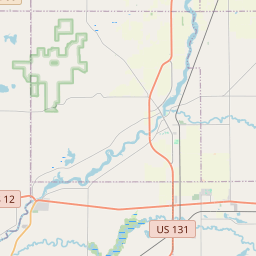Sturgis Prairie
Historical marker location:
Sturgis, Michigan
( Marker is at the intersection of E. Chicago Road (U.S. 12) and Pioneer Avenue, on the right when traveling east on E. Chicago Road.)
Marker installed: 1915







© OpenStreetMap contributors
The Detroit Lions football team was one of the original teams in the National Football League (NFL) when it was founded in 1920. The Lions have played their home games at Ford Field in Detroit since 2002.
About St. Joseph County
St. Joseph County Timeline
St. Joseph County, MI is located in southwest Michigan and has a rich history that dates back centuries. The area was initially inhabited by various Native American tribes, including the Potawatomi. European settlers began arriving in the early 19th century, establishing agricultural communities.
In 1829, St. Joseph County was officially organized and named after the St. Joseph River, which runs through the area. The county experienced rapid growth during the mid-19th century with the construction of rail lines, which connected it to nearby cities and facilitated the transportation of goods. Agriculture, particularly dairy farming, became a major industry in the county during this time, and it remains an important sector to this day.
During the late 19th century, St. Joseph County witnessed the establishment of many towns and villages, including Three Rivers, the county seat, Constantine, and Centreville. These settlements developed around the railroad stations and played significant roles in the county's economic and social development.
In the 20th century, St. Joseph County continued to thrive, despite the challenges of the Great Depression and World War II. The county diversified its economy, with the manufacturing sector gaining prominence alongside agriculture. Today, St. Joseph County preserves its rich history through various historical sites and museums, offering visitors a glimpse into its past while embracing a vibrant present.
In 1829, St. Joseph County was officially organized and named after the St. Joseph River, which runs through the area. The county experienced rapid growth during the mid-19th century with the construction of rail lines, which connected it to nearby cities and facilitated the transportation of goods. Agriculture, particularly dairy farming, became a major industry in the county during this time, and it remains an important sector to this day.
During the late 19th century, St. Joseph County witnessed the establishment of many towns and villages, including Three Rivers, the county seat, Constantine, and Centreville. These settlements developed around the railroad stations and played significant roles in the county's economic and social development.
In the 20th century, St. Joseph County continued to thrive, despite the challenges of the Great Depression and World War II. The county diversified its economy, with the manufacturing sector gaining prominence alongside agriculture. Today, St. Joseph County preserves its rich history through various historical sites and museums, offering visitors a glimpse into its past while embracing a vibrant present.
St. Joseph County Timeline
This timeline provides a condensed summary of the historical journey of St. Joseph County, Michigan.
- 1829 - St. Joseph County is established as a county in the state of Michigan.
- Early 1830s - The first settlements in St. Joseph County are established, including the city of Sturgis.
- 1833 - The county seat is established in Centreville.
- 1834 - The first courthouse in St. Joseph County is built in Centreville.
- Late 1800s - Agriculture becomes a major industry in the county, with the cultivation of crops such as corn and wheat.
- 1890 - The Michigan Central Railroad extends its tracks to St. Joseph County, boosting transportation and trade.
- Early 1900s - The county experiences a period of industrial growth, with the establishment of factories and mills.
- 1953 - The construction of the St. Joseph Valley Parkway (US 131) begins in the county, improving road connectivity.
- Late 20th century - St. Joseph County focuses on diversifying its economy, with the growth of the healthcare, education, and manufacturing sectors.